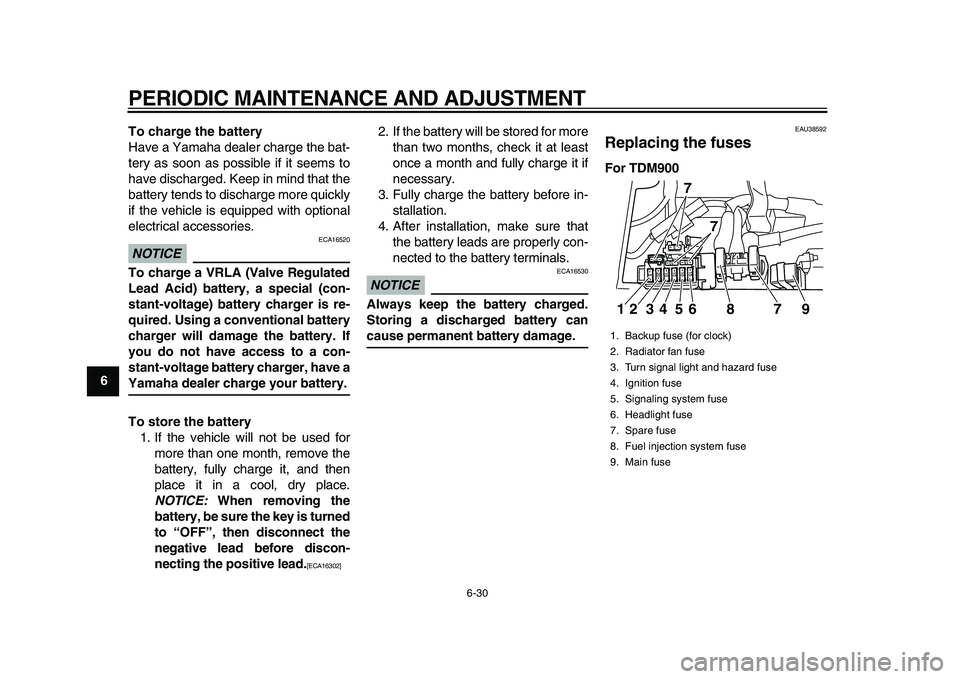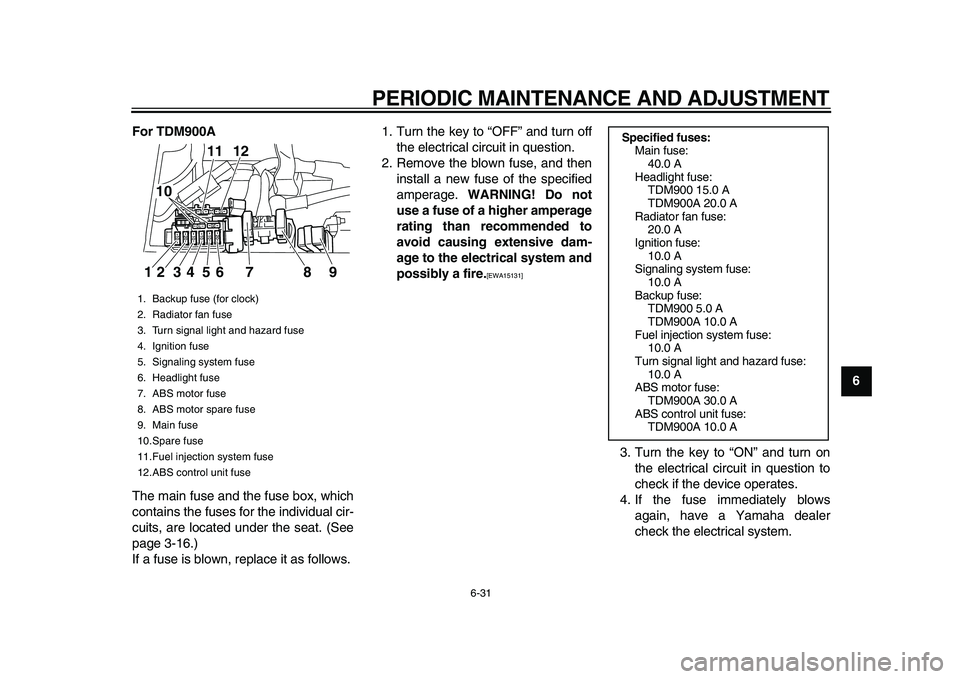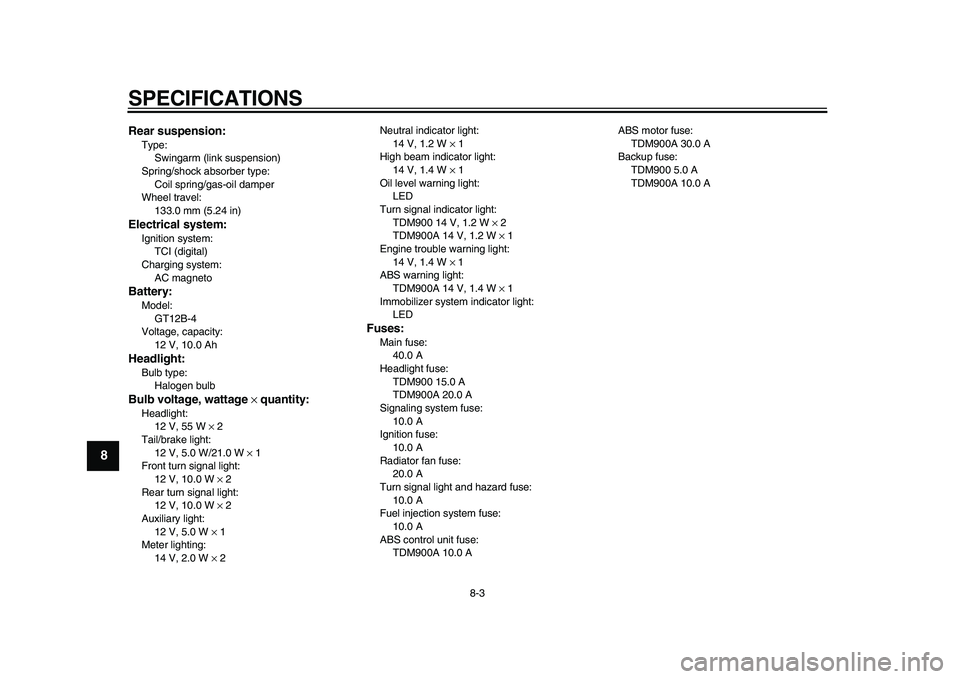Page 76 of 96

PERIODIC MAINTENANCE AND ADJUSTMENT
6-30
1
2
3
4
5
6
7
8
9To charge the battery
Have a Yamaha dealer charge the bat-
tery as soon as possible if it seems to
have discharged. Keep in mind that the
battery tends to discharge more quickly
if the vehicle is equipped with optional
electrical accessories.
NOTICE
ECA16520
To charge a VRLA (Valve Regulated
Lead Acid) battery, a special (con-
stant-voltage) battery charger is re-
quired. Using a conventional battery
charger will damage the battery. If
you do not have access to a con-
stant-voltage battery charger, have a
Yamaha dealer charge your battery.
To store the battery
1. If the vehicle will not be used for
more than one month, remove the
battery, fully charge it, and then
place it in a cool, dry place.
NOTICE:
When removing the
battery, be sure the key is turned
to “OFF”, then disconnect the
negative lead before discon-
necting the positive lead.
[ECA16302]
2. If the battery will be stored for more
than two months, check it at least
once a month and fully charge it if
necessary.
3. Fully charge the battery before in-
stallation.
4. After installation, make sure that
the battery leads are properly con-
nected to the battery terminals.
NOTICE
ECA16530
Always keep the battery charged.
Storing a discharged battery can
cause permanent battery damage.
EAU38592
Replacing the fuses
For TDM900
1. Backup fuse (for clock)
2. Radiator fan fuse
3. Turn signal light and hazard fuse
4. Ignition fuse
5. Signaling system fuse
6. Headlight fuse
7. Spare fuse
8. Fuel injection system fuse
9. Main fuse
12 34 5 6 7 97
7
8
✼✥✯✣✲� ✦✣ �
���
�
����������������
Page 77 of 96

PERIODIC MAINTENANCE AND ADJUSTMENT
6-31
2
3
4
5
67
8
9 For TDM900A
The main fuse and the fuse box, which
contains the fuses for the individual cir-
cuits, are located under the seat. (See
page 3-16.)
If a fuse is blown, replace it as follows.1. Turn the key to “OFF” and turn off
the electrical circuit in question.
2. Remove the blown fuse, and then
install a new fuse of the specified
amperage.
WARNING! Do not
use a fuse of a higher amperage
rating than recommended to
avoid causing extensive dam-
age to the electrical system and
possibly a fire.
[EWA15131]
3. Turn the key to “ON” and turn on
the electrical circuit in question to
check if the device operates.
4. If the fuse immediately blows
again, have a Yamaha dealer
check the electrical system.
1. Backup fuse (for clock)
2. Radiator fan fuse
3. Turn signal light and hazard fuse
4. Ignition fuse
5. Signaling system fuse
6. Headlight fuse
7. ABS motor fuse
8. ABS motor spare fuse
9. Main fuse
10.Spare fuse
11.Fuel injection system fuse
12.ABS control unit fuse
12 34 5 6 7 8 911 12
10
Specified fuses:
Main fuse:
40.0 A
Headlight fuse:
TDM900 15.0 A
TDM900A 20.0 A
Radiator fan fuse:
20.0 A
Ignition fuse:
10.0 A
Signaling system fuse:
10.0 A
Backup fuse:
TDM900 5.0 A
TDM900A 10.0 A
Fuel injection system fuse:
10.0 A
Turn signal light and hazard fuse:
10.0 A
ABS motor fuse:
TDM900A 30.0 A
ABS control unit fuse:
TDM900A 10.0 A
✼✥✯✣✲� ✦✤ �
���
�
����������������
Page 79 of 96

PERIODIC MAINTENANCE AND ADJUSTMENT
6-33
2
3
4
5
67
8
9
EAU24082
Replacing the tail/brake light
bulb
1. Remove the seat. (See
page 3-16.)
2. Remove the socket (together with
the bulb) by turning it counter-
clockwise.
3. Remove the burnt-out bulb by
pushing it in and turning it counter-
clockwise.
4. Insert a new bulb into the socket,
push it in, and then turn it clock-
wise until it stops.
5. Install the socket (together with the
bulb) by turning it clockwise.
6. Install the seat.
EAU24204
Replacing a turn signal light
bulb
1. Remove the turn signal light lens
by removing the screw.
2. Remove the burnt-out bulb by
pushing it in and turning it counter-
clockwise.3. Insert a new bulb into the socket,
push it in, and then turn it clock-
wise until it stops.
4. Install the lens by installing the
screw.
NOTICE:
Do not over-
tighten the screw, otherwise the
lens may break.
[ECA11191]
1. Socket
1
1. Screw
2. Turn signal light lens
12
1. Turn signal light bulb
1
✼✥✯✣✲� ✦✦ �
���
�
����������������
Page 90 of 96

SPECIFICATIONS
8-3
1
2
3
4
5
6
7
8
9
Rear suspension:
Type:
Swingarm (link suspension)
Spring/shock absorber type:
Coil spring/gas-oil damper
Wheel travel:
133.0 mm (5.24 in)
Electrical system:
Ignition system:
TCI (digital)
Charging system:
AC magneto
Battery:
Model:
GT12B-4
Voltage, capacity:
12 V, 10.0 Ah
Headlight:
Bulb type:
Halogen bulb
Bulb voltage, wattage
×
quantity:
Headlight:
12 V, 55 W
×
2
Tail/brake light:
12 V, 5.0 W/21.0 W
×
1
Front turn signal light:
12 V, 10.0 W
×
2
Rear turn signal light:
12 V, 10.0 W
×
2
Auxiliary light:
12 V, 5.0 W
×
1
Meter lighting:
14 V, 2.0 W
×
2Neutral indicator light:
14 V, 1.2 W
×
1
High beam indicator light:
14 V, 1.4 W
×
1
Oil level warning light:
LED
Turn signal indicator light:
TDM900 14 V, 1.2 W
×
2
TDM900A 14 V, 1.2 W
×
1
Engine trouble warning light:
14 V, 1.4 W
×
1
ABS warning light:
TDM900A 14 V, 1.4 W
×
1
Immobilizer system indicator light:
LED
Fuses:
Main fuse:
40.0 A
Headlight fuse:
TDM900 15.0 A
TDM900A 20.0 A
Signaling system fuse:
10.0 A
Ignition fuse:
10.0 A
Radiator fan fuse:
20.0 A
Turn signal light and hazard fuse:
10.0 A
Fuel injection system fuse:
10.0 A
ABS control unit fuse:
TDM900A 10.0 AABS motor fuse:
TDM900A 30.0 A
Backup fuse:
TDM900 5.0 A
TDM900A 10.0 A
✼✥✯✣✲� ✦ �
���
�
����������������
Page 93 of 96
INDEX
Troubleshooting ....................................... 6-35
Troubleshooting charts ............................ 6-36
Turn signal indicator lights ......................... 3-4
Turn signal light bulb, replacing ............... 6-33
Turn signal switch .................................... 3-10
V
Valve clearance ....................................... 6-17
Vehicle identification number..................... 9-1
W
Wheel bearings, checking ....................... 6-29
Wheels..................................................... 6-19
✼✥✯✣✲� ✦ �
���
�
����������������